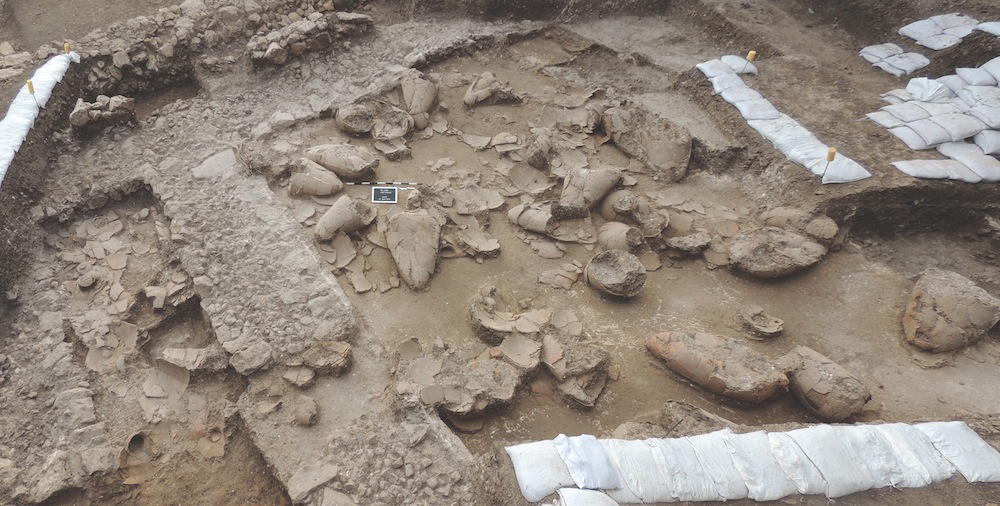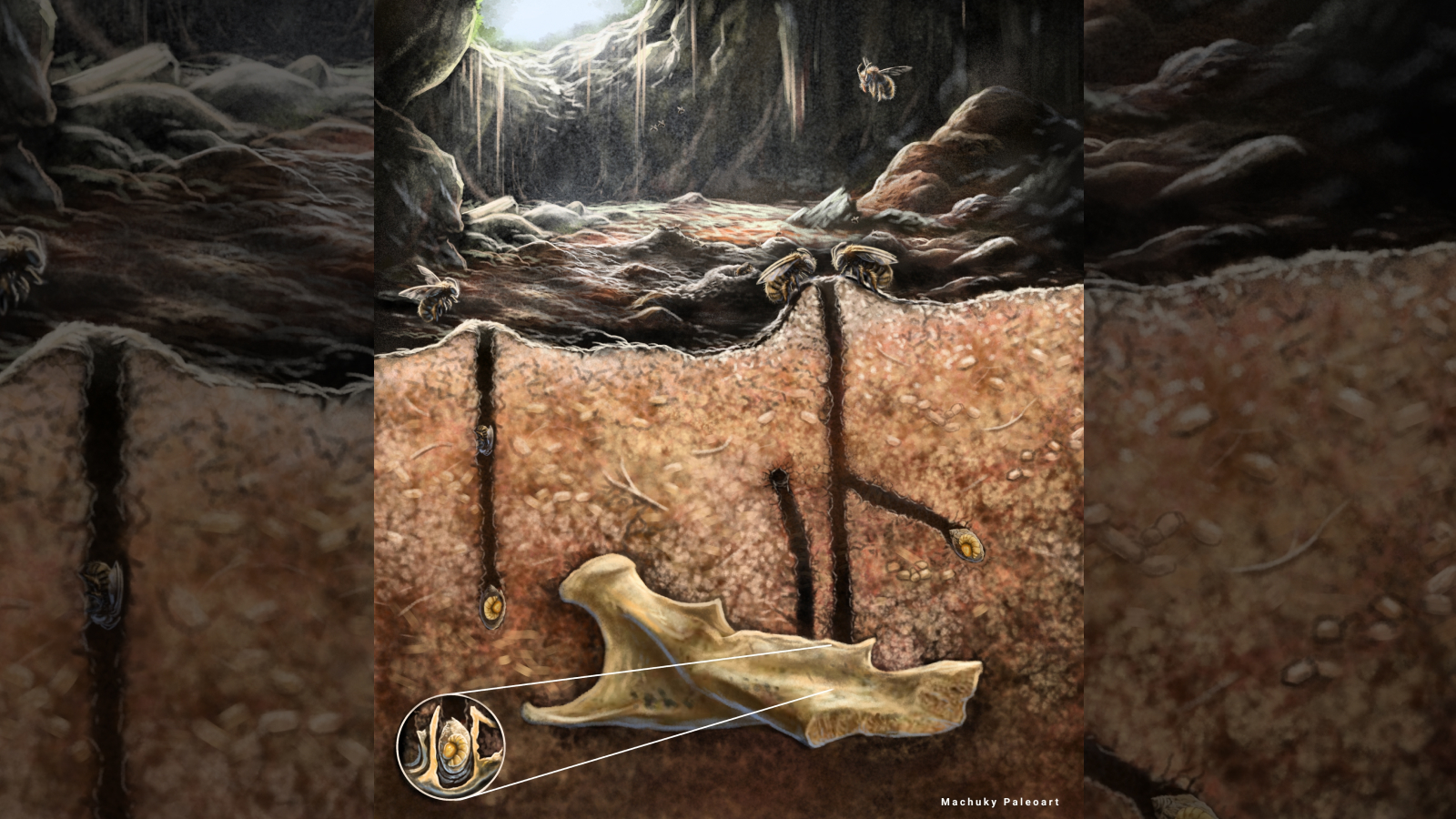World's Oldest Wine Cellar Fueled Palatial Parties

Israel isn't particularly famous for its wine today, but four thousand years ago, during the Bronze Age, vineyards in the region produced vintages that were prized throughout the Mediterranean and imported by the Egyptian elite.
Last summer, archaeologists discovered a rare time capsule of this ancient drinking culture: the world's oldest known wine cellar, found in the ruins of a sprawling palatial compound in Upper Galilee.
The mud-brick walls of the room seem to have crumbled suddenly, perhaps during an earthquake. Whatever happened, no one came to salvage the 40 wine jars inside after the collapse; luckily for archaeologists, the cellar was left untouched for centuries. [In Images: An Ancient Palace Wine Cellar]
Excavators at the site took samples of the residue inside the jars. In a new study published today (Aug. 27) in the journal PLOS ONE, the researchers describe what their chemical analysis turned up: biomarkers of wine and herbal additives that were mixed into the drink, including mint, cinnamon and juniper.
Wild nights in Tel Kabri
Archaeologists unearthed the wine cellar in a palatial complex at a site called Tel Kabri in present-day northern Israel, near the borders of Syria and Lebanon. As far back as the Stone Age, the area's springs attracted settlers. During the second millennium B.C., a more centralized Canaanite community of thousands of people popped up around a palace, which likely housed a leader or ruling family who could redistribute wealth and commodities, said Andrew Koh, an archaeologist at Brandeis University, in Waltham, Massachusetts, and one of the excavators on the dig.
The compound was at its peak between 1900 B.C. and 1600 B.C. Artifacts and paintings found at the site suggest this community had contact with Egypt, Mesopotamian cultures to the north and east, and the Minoan civilization that arose in Crete.
Get the world’s most fascinating discoveries delivered straight to your inbox.
In July, Koh and colleagues were excavating an area they thought was outside the palace when they found a 3-foot-tall (1 meter) jar they dubbed "Bessie." The team eventually turned up 39 more jars inside a room measuring about 16 feet by 26 feet (5 m by 8 m). All together, the vessels would have held around 528 gallons (2,000 liters) of wine, and the cellar was conveniently located next to a banquet hall.
"What we have is quite substantial — 40 jars — but it's not enough to redistribute to the whole countryside, so we're arguing that this is the personal or palatial wine cellar," Koh told Live Science. "It's for a nuclear kind of in-group, whether it's the family or clan, and it's for local, on-the-spot consumption. But it's still a lot of wine — they must have thrown large parties." [The Holy Land: 7 Amazing Archaeological Finds]
What's in the wine
The residue from all 32 jars sampled in the study contained tartaric acid, one of the main acids in wine. In all but three jars, the researchers found syringic acid, a marker of red wine. The absence of syringic acid in those three jars may indicate that they contained some of the earliest examples of white wine, which got its start later than red wine, Koh said.
The researchers found signatures of pine resin, which has powerful antibacterial properties and was likely added at the vineyard to help preserve the wine. Scientists also found traces of cedar, which may have come from wooden beams used during the wine-pressing process.
The researchers noticed that the cellar's simplest wines, those with only resin added, were typically found in the jars lined up in a row against the wall near the outdoor entrance to the room. But the wines with the more complex additives were generally found in jars near a platform in the middle of the cellar and two narrow rooms leading to the banquet hall next door. Koh and colleagues believe the wine would have been brought from the countryside into the cellar, where a wine master would have mixed in honey and herbs like juniper and mint before a meal.
As for the taste, Koh said the ancient booze may have resembled modern retsina, a somewhat divisive Greek wine flavored with pine resin — described by detractors as having a note of turpentine. (Koh said he and his colleagues usually hear two different kinds of remarks about the ancient wine: Some say, "I would love to drink this wine," while others say, "It must have just tasted like vinegar with twigs in it.")
While the wine wouldn't be what drinkers are used to today, the jars at Tel Kabri likely contained some the finest vintages of the day, Koh said.
"If the Egyptian kings and pharaohs wanted wine from this area, it must have been quite good," Koh said.
Recreating old wine from lost grapes
Based on the fabric of the clay jars, the researchers said the wine came from the local region, though they're still trying to pinpoint where the supplying vineyards may have been located. The scientists do know that one of the most famous vineyards of antiquity, the Bethanath estate, got its start about 1,000 years later, just 9 miles (15 km) away from Tel Kabri.
Koh and colleagues are also hoping DNA tests reveal what kind of grapes were used, which may interest not only archaeologists but also current wine producers.
The Islamic conquest of the 7th century put an end to much of the region's wine culture. It wasn't until the 19th century that Upper Galilee's vineyards experienced a revival, largely thanks to Baron Edmond de Rothschild, who imported grapes from Bordeaux, France, that still form the basis of much of Israel's wine culture today, Koh said. But these grapes are perhaps not the best varieties for the region's climate.
"It's fascinating that grapes [originally] came from this general region, but [in Israel] they're growing grapes that over many centuries have acclimated to the Atlantic coast of France," said Koh. "So if we can get DNA from our wine cellar, we'll have this genetic blueprint of presumably wine that for centuries was best suited to grow in the land we call Israel today."
The researchers hope to eventually look for a DNA match between the traces of Tel Kabri's wine and feral grapes in the region that might have been cultivated in antiquity and somehow survived into the present, Koh said.
Follow Megan Gannon on Twitter and Google+. Follow us @livescience, Facebook & Google+. Original article on Live Science.



